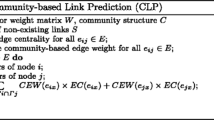Abstract
Community detection is an important step of network analysis that relies on the correctness of edges. However, incompleteness and inaccuracy of network data collection methods often cause the communities based on the collected datasets to be different from the ground truth. In this paper, we aim to recover or improve the network community structure using scores provided by different link prediction techniques to replace a fraction of low ranking existing links with top ranked predicted links. Experimental results show that applying our approach to different networks can significantly refine community structure. We also show that predictions of edge additions and persistence are confirmed by the future states of evolving social networks. Another important finding is that not every metric performs equally well on all networks. We observe that performance of link prediction ranking is correlated with certain network properties, such as the network size or average node degree.
This work was supported in part by the ARL under Cooperative Agreement Number W911NF-09-2-0053 and by the Office of Naval Research Grants No. N00014-09-1-0607 and N00014-15-1-2640, and by the EU’s 7FP Grant Agreement No. 316097 and by the Polish National Science Centre, the decision no. DEC-2013/09/B/ST6/02317.
Access this chapter
Tax calculation will be finalised at checkout
Purchases are for personal use only
Similar content being viewed by others
References
Fortunato, S.: Community detection in graphs. Phys. Rep. 486, 75–174 (2010)
Yan, B., Gregory, S.: Finding missing edges and communities in incomplete networks. J. Phys. A 44, 495,102 (2011)
Chen, M., Kuzmin, K., Szymanski, B.: Community detection via maximization of modularity and its variants. IEEE Trans. Comput. Soc. Syst. 1(1), 46–65 (2014)
Yan, B., Gregory, S.: Finding missing edges in networks based on their community structure. Phys. Rev. E 85(5), 056,112 (2012)
Lancichinetti, A., Fortunato, S., Radicchi, F.: Benchmark graphs for testing community detection algorithms. Phys. Rev. E 78, 046,110 (2008)
Liu, Z., He, J.L., Kapoor, K., Srivastava, J.: Correlations between community structure and link formation in complex networks. PLoS ONE 8, 72,908 (2013)
Liu, Z., Dong, W., Fu, Y.: Local degree blocking model for missing link prediction in complex networks (2014). arXiv:1406.2203
Yan, B., Gregory, S.: Detecting community structure in networks using edge prediction methods. J. Stat. Mech: Theory Exp. 2012(09), P09,008 (2012)
Burgess, M., Adar, E., Cafarella, M.: Link-prediction enhanced consensus clustering for complex networks (2015). arXiv:1506.01461
Lichtenwalter, R.N., Chawla, N.V.: LPmade: link prediction made easy. J. Mach. Learn. Res. 12, 2489–2492 (2011)
Adamic, L., Adar, E.: Friends and neighbors on the Web. Soc. Netw. 25(3), 211–230 (2003)
Lichtenwalter, R.N., Lussier, J.T., Chawla, N.V.: New perspectives and methods in link prediction. In: Proceedings of the 16th ACM SIGKDD International Conference Knowledge Discovery and Data Mining, pp. 243–252. New York, NY, USA (2010)
Gaiteri, C., Chen, M., Szymanski, B.K., Kuzmin, K., Xie, J., Lee, C., Blanche, T., Neto, E.C., Huang, S.C., Grabowski, T., Madhyastha, T., Komashko, V.: Identifying robust clusters and multi-community nodes by combining top-down and bottom-up approaches to clustering. Scientific Reports 5 (2015)
Xie, J., Szymanski, B.K., Liu, X.: SLPA: Uncovering overlapping communities in social networks via a speaker-listener interaction dynamic process. In: Proceedings of the Data Mining Technologies for Computational Collective Intelligence Workshop, pp. 344–349. IEEE (2011)
Newman, M.E.J., Girvan, M.: Finding and evaluating community structure in networks. Phys. Rev. E 69, 026,113 (2004)
Chen, M., Nguyen, T., Szymanski, B.K.: A new metric for quality of network community structure. ASE Human J. 2(4), 226–240 (2013)
Lancichinetti, A., Fortunato, S., Kertész, J.: Detecting the overlapping and hierarchical community structure in complex networks. New J. Physics 11(3), 033,015 (2009)
Li, Z., Zhang, S., Wang, R.S., Zhang, X.S., Chen, L.: Quantitative function for community detection. Phys. Rev. E 77, 036,109 (2008)
Nguyen, T., Chen, M., Szymanski, B.: Analyzing the proximity and interactions of friends in communities in Gowalla. In: Proceedings of the IEEE 13th International Conference Data Mining Workshops (ICDMW), pp. 1036–1044 (2013)
Yang, J., Leskovec, J.: Defining and evaluating network communities based on ground-truth. In: Proceedings of the ACM SIGKDD Workshop on Mining Data Semantics, pp. 3:1–3:8. ACM, New York, NY, USA (2012)
Girvan, M., Newman, M.E.J.: Community structure in social and biological networks. Proc. Natl Acad. Sci. USA 99(12), 7821–7826 (2002)
Lusseau, D., Schneider, K., Boisseau, O.J., Haase, P., Slooten, E., Dawson, S.M.: The bottlenose dolphin community of Doubtful Sound features a large proportion of long-lasting associations. Behav. Ecol. Sociobiol. 54(4), 396–405 (2003)
Zachary, W.: An information flow model for conflict and fission in small groups. J. Anthropol. Res. 33, 452–473 (1977)
Tang, J., Zhang, J., Yao, L., Li, J., Zhang, L., Su, Z.: ArnetMiner: Extraction and mining of academic social networks. Phys. Rev. E 78, 046,110 (2008)
Author information
Authors and Affiliations
Corresponding author
Editor information
Editors and Affiliations
Rights and permissions
Copyright information
© 2016 Springer International Publishing Switzerland
About this chapter
Cite this chapter
Chen, M., Bahulkar, A., Kuzmin, K., Szymanski, B.K. (2016). Improving Network Community Structure with Link Prediction Ranking. In: Cherifi, H., Gonçalves, B., Menezes, R., Sinatra, R. (eds) Complex Networks VII. Studies in Computational Intelligence, vol 644. Springer, Cham. https://doi.org/10.1007/978-3-319-30569-1_11
Download citation
DOI: https://doi.org/10.1007/978-3-319-30569-1_11
Published:
Publisher Name: Springer, Cham
Print ISBN: 978-3-319-30568-4
Online ISBN: 978-3-319-30569-1
eBook Packages: EngineeringEngineering (R0)




